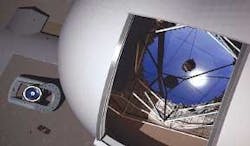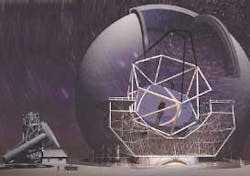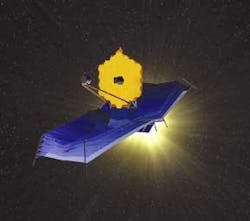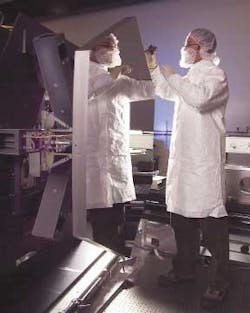By Ben Ames
GREENBELT, Md. — In eight years, astronomers expect to have two new tools that could let them solve many of the mysteries in today's skies.
The James Webb Space Telescope, managed at the NASA Goddard Space Flight Center in Greenbelt, Md., is set to reach orbit in 2011. The international Atacama Large Millimeter Array (ALMA) is a ground-based telescope scheduled to go active in 2012.
Those tools may lead to an even more ambitious project — researchers say they will need a third instrument to exploit the new data fully.
Engineers are planning an Earth-based telescope with an enormous mirror that measures 30 meters in diameter — the largest ever built. For more information, see www.aura-nio.noao.edu.
This drawing of the Thirty Meter Telescope, better known as the TMT, in its dome shows how the telescope would look from above. The disk at left is a 5-meter-diameter mirror for comparison.
This "Thirty-Meter Telescope," better known as the TMT, would reinforce data from the Webb Telescope and ALMA by matching its instruments to the Webb's light sensitivity and to the image sharpness of ALMA. Researchers will collect infrared data from Webb, millimeter-wave data from ALMA, and infrared and optical data from TMT.
Building the TMT will require a burst of research into its enabling technologies, says Larry Stepp, manager of the Association of Universities for Research in Astronomy (AURA) New Initiatives Office in Washington.
In addition to AURA, TMT partners include the Association of Canadian Universities for Research in Astronomy, the University of California at Berkeley, and the California Institute of Technology in Pasadena, Calif. For more information, see http://tmt.ucolick.org.
The U.S. National Research Council in Washington recommends TMT for the highest priority federal astronomy funding between 2001 and 2010, with additional money coming from the private Gordon and Betty Moore Foundation in San Francisco and the National Science Foundation in Arlington, Va.
TMT designers have their work cut out for them. In terms of the physical telescope and optics, engineers will enlarge current technology from the two 10-meter Keck Observatory Telescopes now sitting atop Hawaii's Mauna Kea volcano, Stepp says.
That would give TMT nine times the collecting area and three times the image sharpness of Keck. But first, workers must find a way to stabilize the huge structure from wind buffeting.
Another optical challenge is shrinking the cost of the 1,000 reflective segments that will form the main mirror, Stepp says. The toughest challenge will be designing the adaptive optics.
Engineers must compensate for image distortion caused by atmospheric turbulence, although the technology does not yet exist to do this in such a large telescope, Stepp says.
Engineers have suggested three new types of experimental adaptive optics for the task: multiconjugate, multi-object, and ground-layer. There aren't any working prototypes of these systems because researchers need improved simulation tools and physical components.
Specifically, researchers need enhanced components such as deformable mirrors, charged-couple-device (CCD) wavefront detectors, high-power lasers, and real-time signal-processing electronics to tilt the mirrors, Stepp says.
One way to accelerate this research is to borrow from military programs.
The Webb Space Telescope shields its 18-piece mirror from the Sun's heat in this computer-generated image.
"This technology comes from the whole 'swords and plowshares' balance; we would never be able to do this if we hadn't been terrified of the Russians 20 years ago," says John C. Mather, senior project scientist at NASA Goddard. "All these detectors were first designed by the military to look at Earth. So we just needed to turn them around and adjust them to look out into space."
The primary goal of this telescopic trio is to study the birth and evolution of galaxies, specifically seeking the first light generated after the Big Bang, Mather says. The current theory for the creation of the universe places the Big Bang about 13.7 billion years ago, with the creation of the Earth and the sun about 4.5 billion years ago.
The oldest light is the faintest, so researchers will aim the Webb telescope at parts of space that appear to be the most empty. "The pretty stuff you can see in the night sky has been thoroughly explored already," Mather says.
For instance, the star Vega has a large cloud of dust around it, which may be in the process of coalescing into a planet. The dust doesn't emit any visible light, but the Webb will sense the dust cloud's infrared emissions to calculate its chemical composition and atmosphere.
For this reason, astronomers use an array of space-based sensor technologies. They include visible-light sensors on the Hubble Space Telescope, gamma rays for the Compton Gamma Ray Observatory, x-rays for the Chandra X-ray Observatory, and infrared for the Spitzer Space Telescope (formerly known as SIRTF).
Those platforms all use smaller mirrors than the three new ones — Webb, ALMA, and TMT; researchers could lose Hubble soon, if NASA administrators follow through on plans to cancel space-shuttle maintenance missions.
Another optical challenge is shrinking the cost of the 1,000 reflective segments that will form the main mirror. The toughest challenge will be designing the adaptive optics.
Space-based telescopes do not have to use adaptive optics to correct for peering through the Earth's atmosphere; the biggest advances in space-telescope technology come from the mirrors, which rely on near-perfect calibration and lightweight materials to catch maximum radiation, Mather says.
For example, the Webb telescope will use a 6.5-meter mirror, which is seven times the size of Hubble's, enabling it to see objects 400 times fainter than the best telescopes can see today.
Still, Webb's mirror is much lighter than Hubble's; the Webb's mirror is made of 18 lightweight, segmented beryllium sections, each one nanodimensionally stable and cryogenically cooled, says Sally Koris, a Northrop Grumman spokeswoman.
Northrop Grumman won the $825 million prime contract to build the Webb telescope, with components from Ball Aerospace and Eastman Kodak. The funding comes partly from NASA ($1.6 billion) and partly from the European and Canadian space agencies ($2 billion).
Beryllium dust is poisonous, making it difficult to manufacture, but in finished form, it is very light and hard, Mather says. At 15 to 20 kilograms per square meter, it is 10 times less dense than Hubble's mirror. By comparison, the Spitzer telescope uses a 0.85-meter mirror from Lockheed Martin Space Systems in Sunnyvale, Calif., and launched in 2003. Today it is managed by NASA's Jet Propulsion Laboratory in Pasadena, Calif. For more information, see www.spitzer.caltech.edu.
Mirrors on Earth-based telescopes are far bigger. When workers finish construction on the ALMA unit on a 16,400-foot mountaintop in Chile, it will gather millimeter-wave radiation with 64 separate 12-meter antennas. That effort is funded by the U.S. National Science Foundation as well as agencies in Canada and Europe. For more information, see www.mma.nrao.edu.
As for sensors, the Webb telescope will use a suite that includes a near-infrared camera (from the University of Arizona), a near-infrared spectrograph (from the European Space Agency, ESA), a fine guidance sensor — tunable filter module (from the Canadian Space Agency), and a mid-infrared imager (from the ESA and NASA).
It will beam that data back to Earth at 464 gigabytes per day — a comparable rate to Hubble — using the global array of radio-telescopes called the Deep Space Network, Mather says.
Webb will hover at a spot in space where the Earth's and Sun's gravity fields strike a balance. Sitting at the second Lagrange point (L2), it will be 930,000 miles from Earth, on the far side from the Sun. That is nearly four times the Earth-moon distance, which will help keep the instruments cool. The telescope will also use a five-layer sunshield to block the heat, keeping it at 45 Kelvin (-370 degrees Fahrenheit). For more information, see www.jwst.nasa.gov.




